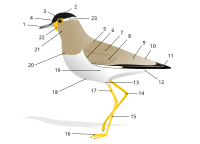
Photo from wikipedia
Spermatozoa exhibit remarkable levels of morphological diversification among and within species. Among the passerine birds, the zebra finch (Taeniopygia guttata) has become a model system for studies of sperm biology,… Click to show full abstract
Spermatozoa exhibit remarkable levels of morphological diversification among and within species. Among the passerine birds, the zebra finch (Taeniopygia guttata) has become a model system for studies of sperm biology, yet studies of closely related Estrildidae finches remain scarce. Here, we examine sperm morphology in the masked finch (Poephila personata) and place the data into the broader context of passerine sperm morphology using data for an additional 189 species. The masked finch exhibited high levels of within- and among-male variation in total sperm length and in specific sperm components. Furthermore, among-male variance in sperm length was significantly greater in estrildid (N = 12) compared with non-estrildid species (N = 178). We suggest that the high variation in sperm morphology in the masked finch and other estrildid species is likely to be linked to low levels of sperm competition, hence relaxed or weak selection on sperm length, in the clade. Our findings highlight that the highly variable sperm of the masked finch and widely studied zebra finch are ‘typical’ for estrildid species and stress the relevance of studying groups of closely related species. Finally, we suggest that further studies of Estrildidae will enhance our understanding of sperm diversity and avian diversity more generally.
Journal Title: Biological Journal of The Linnean Society
Year Published: 2021
Link to full text (if available)
Share on Social Media: Sign Up to like & get
recommendations!